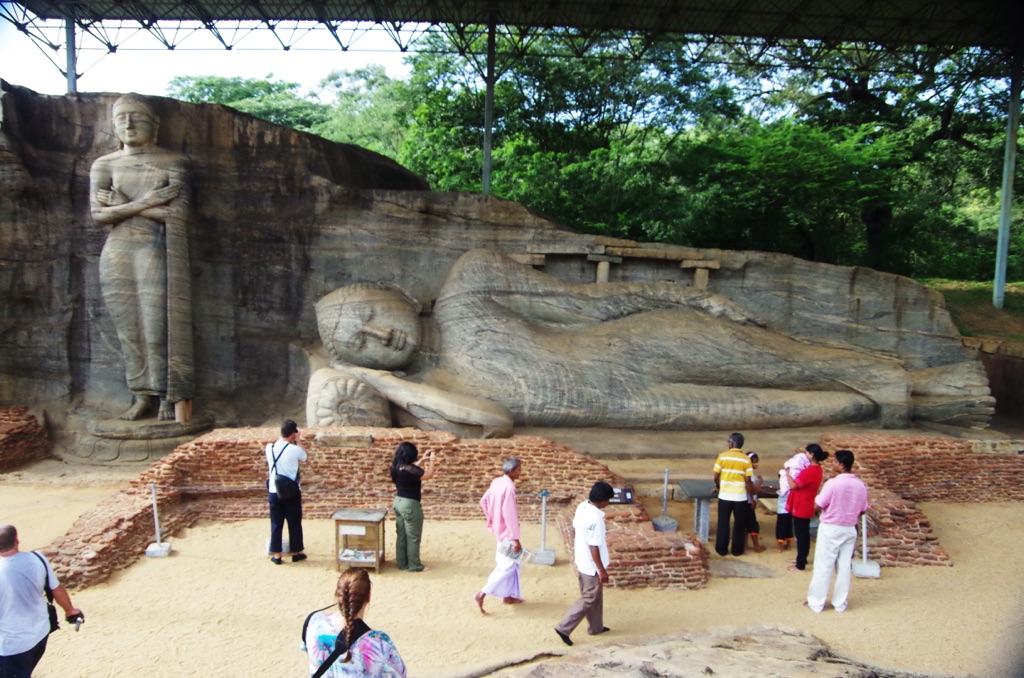Gal Vihara, a rock temple of the Buddha situated in the ancient city of Polonnaruwa in Sri Lanka, is a testament to the region’s rich cultural and religious history. This impressive archaeological site features a series of large Buddha statues carved out of a granite cliff. The sculptures date back to the 12th century and are considered some of the best examples of Sinhalese rock carving and sculpture. The site is part of the Cultural Triangle of Sri Lanka and is a UNESCO World Heritage Site, attracting scholars and tourists alike with its historical significance and artistic beauty.
Get your dose of History via Email
Historical Background of Gal Vihara
Gal Vihara’s discovery dates back to the early 19th century when antiquarians and colonial officers began exploring ancient Ceylonese sites. H.C.P. Bell, the British Archaeological Commissioner for Ceylon, conducted extensive research and documentation at Polonnaruwa, including Gal Vihara. The temple was built during the reign of King Parakramabahu I in the 12th century. It was part of the king’s substantial contribution to the development of Polonnaruwa as a city of gardens and monuments.
The site was originally known as the Uttararama (Northern Monastery) and served as a vibrant religious center. Over time, the temple fell into disuse and was reclaimed by the jungle. It was not until the British period that the site was cleared and its significance rediscovered. The temple complex has since undergone several restoration and preservation efforts to maintain its historical integrity.
Gal Vihara was not just a religious site but also a center of learning and meditation. Monks and scholars likely inhabited its halls, contributing to the spread of Theravada Buddhism throughout the region. The temple’s serene environment provided an ideal setting for contemplation and study.
While the site has not been the scene of major historical events, its construction reflects the peak of the Polonnaruwa period’s artistic and architectural achievements. The statues themselves are a source of national pride and are emblematic of Sri Lanka’s Buddhist heritage.
The temple complex has withstood the test of time, surviving invasions, colonialism, and natural decay. Today, it stands as a symbol of the country’s resilience and the enduring legacy of its ancient civilizations.
About Gal Vihara
Gal Vihara boasts four main statues, all carved from a single, large granite rock face. These include two seated figures, one standing figure, and one reclining figure, each depicting the Buddha in iconic postures. The statues are notable for their realistic representation and the sense of compassion they convey.
The largest of the seated statues is 15 feet tall, and the reclining Buddha measures an impressive 46 feet in length, symbolizing the Buddha’s parinirvana – the final state of nirvana after death. The rock face itself serves as a natural backdrop, enhancing the statues’ grandeur.
The construction techniques of Gal Vihara reflect the advanced skills of the Sinhalese sculptors of the time. They used chisels and hammers to carve the figures directly out of the rock, a process that required precision and artistic vision. The smooth lines and detailed expressions of the statues are a testament to their craftsmanship.
Architectural highlights include the intricate carvings on the robes of the Buddha figures and the lotus pedestals on which they sit. These details not only add to the aesthetic appeal but also carry symbolic meaning within Buddhist iconography.
Despite centuries of exposure to the elements, the statues have retained much of their original detail. This durability is a testament to the quality of both the materials used and the techniques employed by the ancient sculptors.
Theories and Interpretations
Several theories exist about the specific identities of the figures at Gal Vihara. Some scholars suggest that the standing Buddha is a representation of Ananda, the Buddha’s disciple, mourning his passing. Others believe it depicts the Buddha himself.
The purpose of Gal Vihara has also been a subject of debate. While it clearly served as a place of worship, some suggest it was also an educational center where monks would study and meditate.
The exact meanings of the poses and expressions of the Buddha statues are interpreted in various ways. For instance, the smile of the standing Buddha is sometimes seen as a sign of the serenity of enlightenment.
Dating of the site was primarily done through historical records and inscriptions. The reign of King Parakramabahu I is well-documented, allowing for accurate dating of the temple’s construction to the 12th century.
The site continues to be a focus of archaeological and historical research, with new findings occasionally offering fresh insights into its construction and use.
At a glance
Country: Sri Lanka
Civilization: Sinhalese
Age: 12th Century AD

